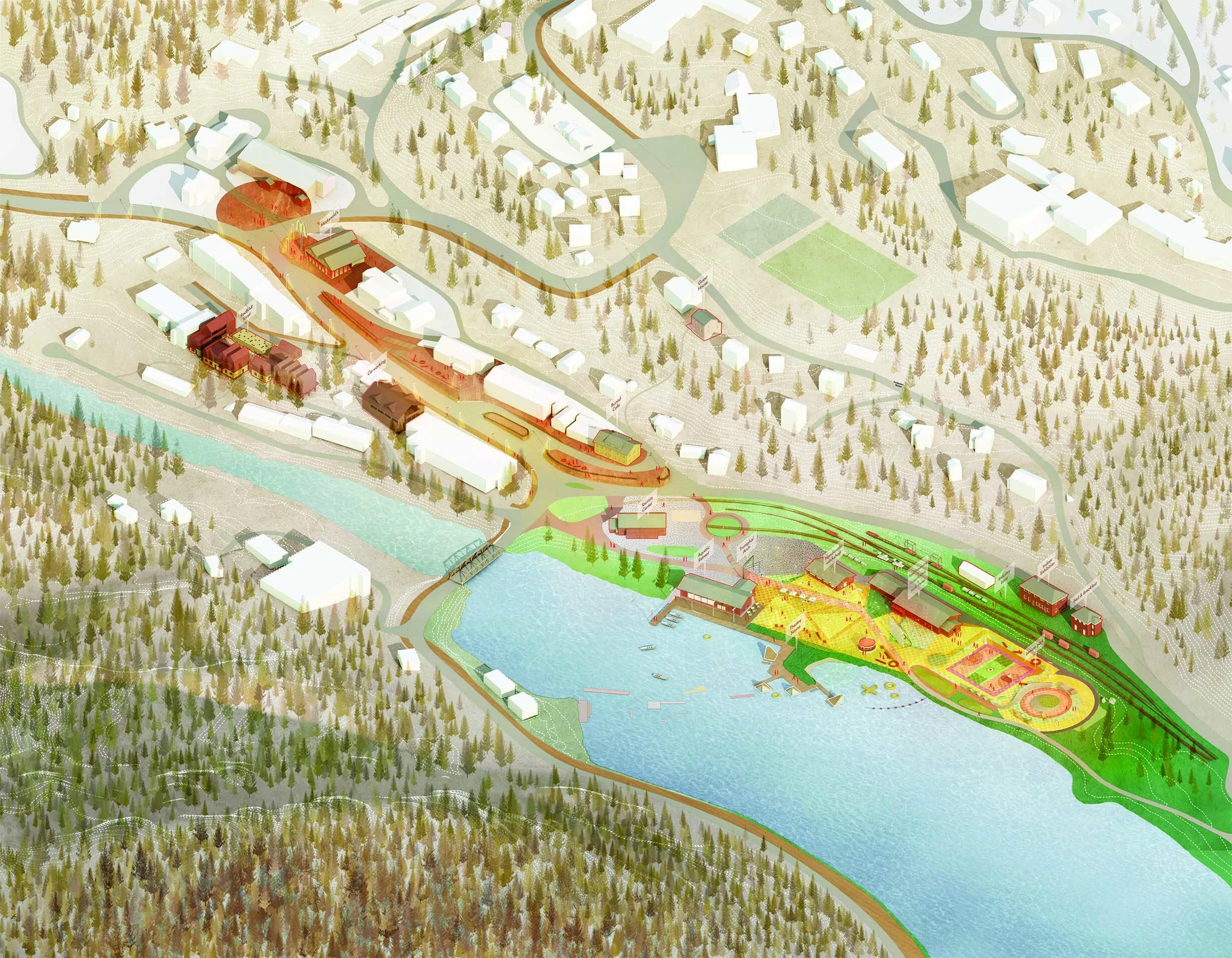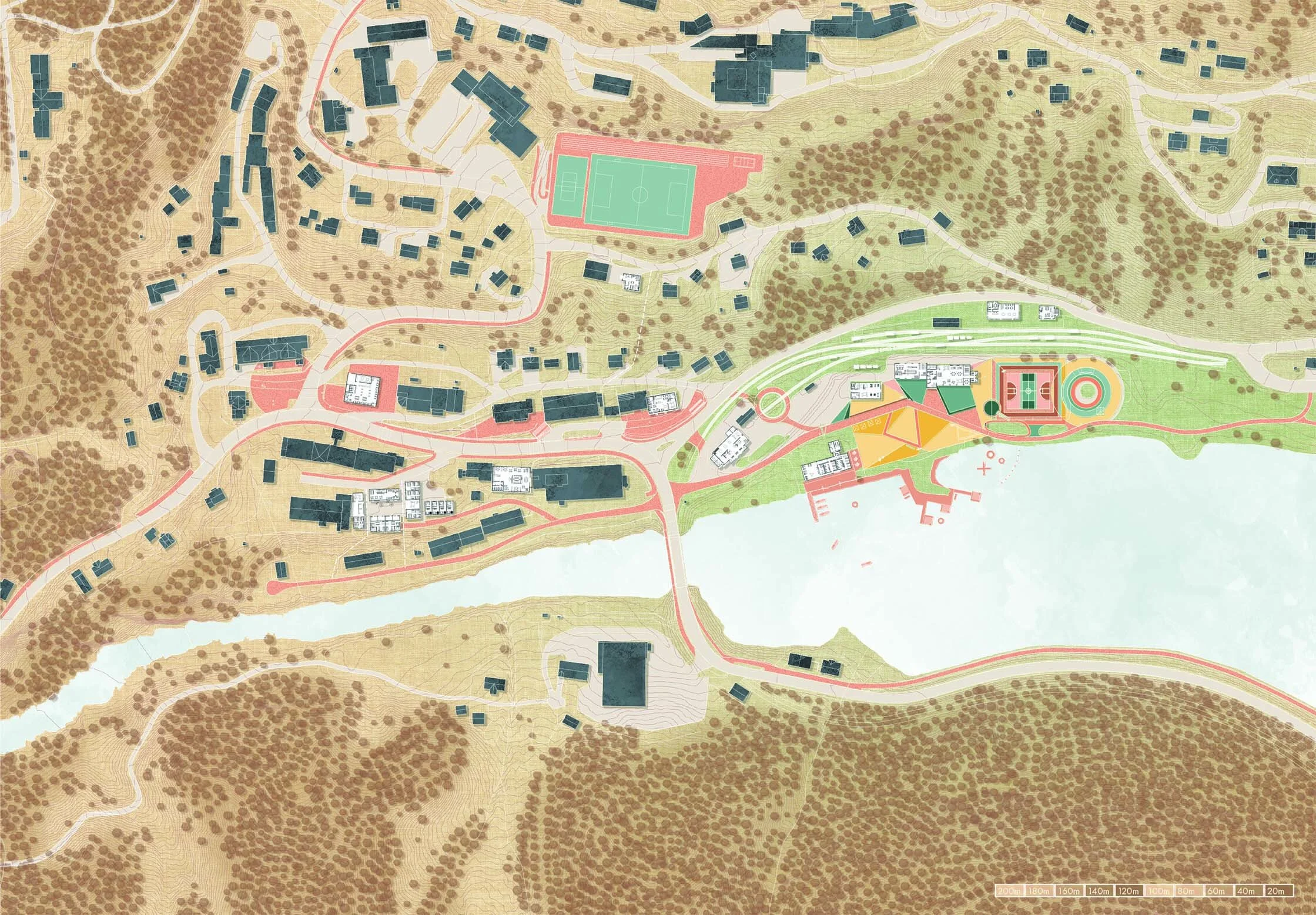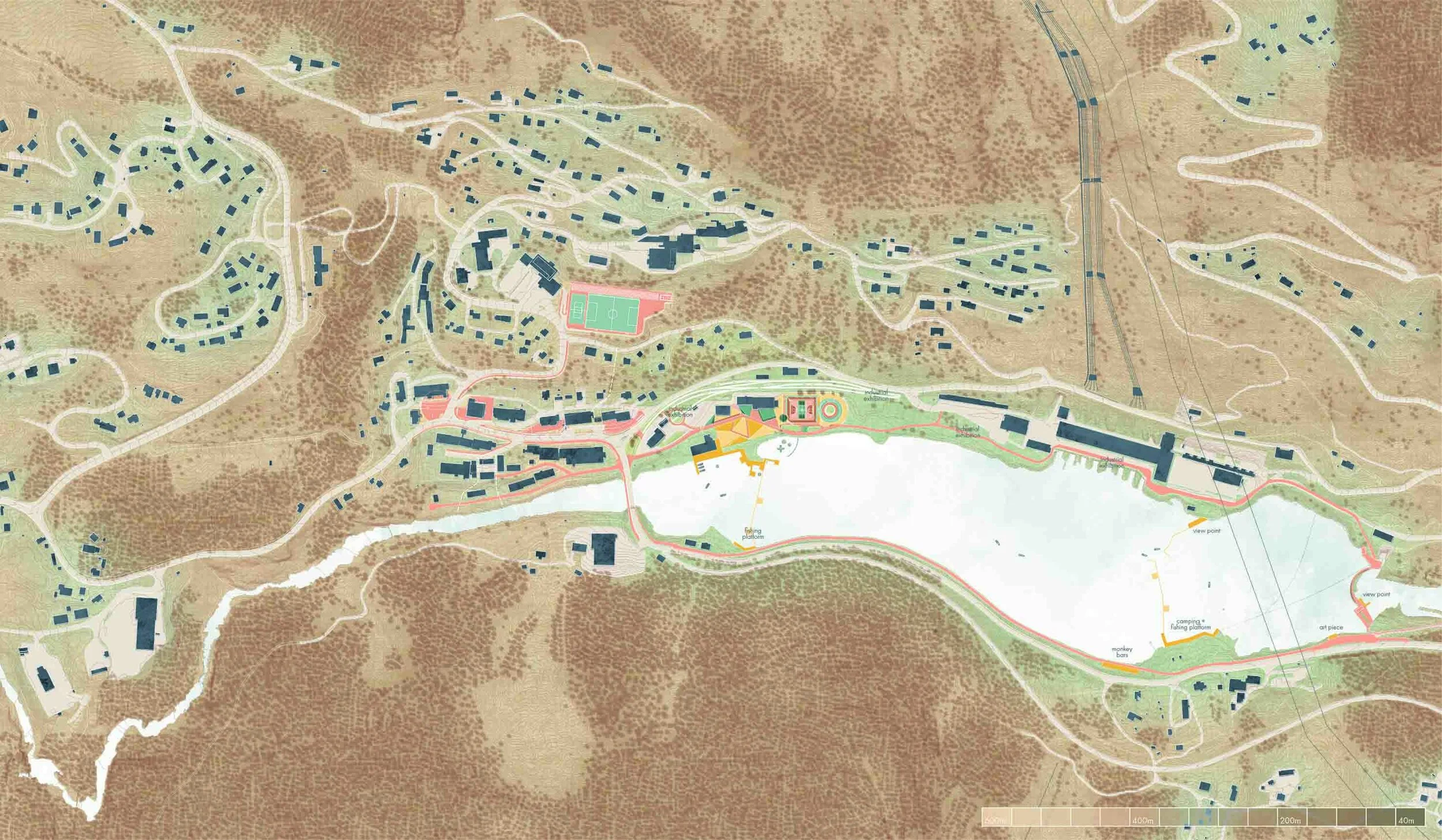
Europan 15
The Eventful
-
July 2019.
-
Rødberg, Nore og Uvdal, Norway
-
Europan is an esteemed international biennual competition, encouraging young architects and urbanists under 40, to address social and economic challenges in towns and cities throughout Europe. This is the second and last round of the topic, Productive Cities.
-
Tin Phan (NO)
Phoebe Chu (HK)
Jan Godzimirski (PL)
Eakapobh Huangthanapan (TH) -
The site of Rødberg poses major contradictions between intrinsic and transient cultures. The village is perceived as less attractive than the others nearby, in a cultural and geographical context. As a place in both permanent decline and temporary increase in population, it requires oversized venues to be used by an undersized society. The demand for public spaces by visitors, far outranks what the locals can maintain themselves. This entry investigates the bare minimum to act upon, in order to find balance between these great opposites, and highlight what is the distinctiveness of Rødberg.
Proposal
This entry elaborates upon what is already there: an expanded event infrastructure scheme, that can efficiently shift between occasional events and everyday-use whenever it suits Rødberg and combining the needs of the locals, visitors and cabin owners. This infrastructure does not only inhabit existing spaces, but consists mainly of transformations. In doing so, one is able to simultaneously able to secure relevance/increased use, and decrease cost and built volumes of any intervention proposed on site. The idea is not only to capitalise upon the genre of man-made events, but to increase the volume of it. By creating a feasible long-term development strategy that answers the site’s contradictions of both permanent and temporary character, one is also able to tap into the zeitgeist of Rødberg - the place at the crossroads of many great cultures. Thus, it will be possible to evoke a hybrid, yet beneficial identity for Rødberg, including the transient and intrinsic elements as a whole.
The proposed development of event infrastructure is an attempt to also create a low-risk, yet flexible testbed for a legitimate development strategy that can organically mature over time with further iterations, as to what constitutes success and attractivity in Rødberg. This idea will also inform the work in phase 3. This entry focuses on developing only the necessary, and intentionally put more emphasis on the western parts of the project site, rather than in its entirety.
Context
Rødberg is the commercial and administrative centre in Nore & Uvdal municipality. It is situated at the crossroads amid other more popular, yet dispersed cabin areas & farmlands, recreational landscape, and distinct landmarks. The village has greatly benefited from this financially, as the Kiwi is definite pit-stop for restocking groceries in the region, as it is currently the enterprise with the highest revenue stream in Nore & Uvdal, outranking the hydropower plant that the village is known for. The village also has a great variety of businesses located in the main street, and that is considered a quality to be preserved and further developed in the future. Contrary to many other locations in the area, as of 2019 Nore & Uvdal is currently experiencing a steady decline in population, going from almost 3400 to 2500 over the course of 50 years. According to SSB, the decline is expected to continue over the next 20 years. In such a delicate situation, any mistakes leaping forward can also cause the development going backwards. It will be crucial to investigate lean ways ofgenerating attractivity to deal with this challenge.
Analysis
The research of this site goes into four separate topics conveying the contradictions and polar opposites between intrinsic and transient cultures, the permanent and the temporary nature of Rødberg. They are as following:
Fluctuating identity - due to attractive cabin and recreational areas, the population of municipality fluctuates from 2500 and up to 20.000 (8 times its current size) during high season. The decline and increase in both permanent residents and temporary visitors create a contradictory demand for services, that requires oversized venues to an undersized society. It has been noted in the brief that the village has not succeeded in becoming an attractive destination in its own right. Kiwi gives a clue to why this is so, being the most successful enterprise in the area, it also means that Rødberg is ultimate car-friendly place to restock on supplies, while the social life is consumed somewhere else.Are there any other concepts in the same vein as Kiwi, that also can be of cultural significance locally? If cabin owners alone stay on average 58 days per year and make up for 22 million Euros in consumption a year in Nore & Uvdal, should not this culture be integral to Rødberg? Are there any ways to encourage the cabin owners to stay for a bit longer when in town?
An eventful place - Nore & Uvdal is the home of multiple annual events and festivals, mainly set in the villages of Uvdal and Rødberg. 5 outdoors-related events are organized in Uvdal, while only the 3 “man-made”, yet hugely popular events are set in Rødberg (the ones focused on human capital and production). There seems to be a huge potential in expanding upon the man-made events. Despite having several existing meeting places, the locals claim that the social meeting venues are lacking. Although Rødberg’s Day alone has created a need for more public spaces suitable for visitors, the everyday use of the existing ones is low.This shows how difficult it is to succeed in such a contradictory and compelling environment, where there is a need for oversized venues to an undersized society is not able to use and maintain. It would therefore be highly beneficial to explore multipurposed infrastructures such as buildings and spaces, to increase the relevance and use of each space befitting both the locals, cabin owners and visitors.
Generating attractivity - a study on successful rural municipalities in Norway show that crucial factors were rooted in authentic reading of a place, and to seize the opportunities whenever they present themselves. Contrary to popular belief, more jobs are not created by only focusing on the “right” businesses or building more office spaces, and population does not increase by managing the local economy properly. Neither was there any definite blueprint on how to successfully design and implement a development strategy for any of these municipalities. What was crucial, was not the action of doing things, but the reasoning behind the act itself.The research also points out that it is critical for the rural municipalities to foster jobs locally. This is due to the fact that there is no feasible strategy for public transport connecting rural areas, which makes commuting between rural places difficult.
Automated transport strategy - Nore & Uvdal is an exceptional forerunner to test out commuting strategies for highly scattered societies (99,8% live in single-family houses), where a time and cost efficient public transport might prove impossible (A). To proposal for this is a rare combination of multiple automated shuttles, simultaneously feeding a single bus shuttle (B), which addresses the time issue in a scattered society. The cost efficiency is a bit more intricate to measure. Looking at it for the long term, a more connected society (across locals and cabin owners), also means Rødberg can be strengthened, commercially, socially and culturally. A functional public transportation, also means more robust labour market in the region, lessening the dependency of generating jobs locally. This means focus can be redirected towards developing other qualities that is intrinsic to Rødberg.
Triumphal Arch
The arch is to make Rødberg more significant as the main place for the man-made events in the region. This is to solidify and expand upon further revenue streams from these types of activities. Even if the outdoors events near Uvdal are geographically locked there, they still require ceremonial venues/spaces which could be capitalised upon locally in Rødberg, where the arch will serve as the perfect arrival/departure spot of any adventure. The programmatic constellation surrounding the arch is to give a quick intro for the cabin owners to the local and regional qualities: a bunad (national folk costume) café to showcase the local bunads and other textiles, and an expanded tourist center with rental for summer/winter activities to experience the natural wildlife.
Aquatic Retreat
The aim with this retreat is to create a more sensible connection between the mainland and the dam and its local environment. This is achieved through piers that connects to a gym, bath, saunas, stage, and provide access to smaller paddle and fishing boats. The formation of these elements also creates a stage in relation with the arena, for different occasions. The design purposely creates nuances of privacy for daily water activities, as there has been remarks by the locals of feeling like being on display for the main road on the opposite side when bathing in the dam.
With the concept of temporary floating docks, the shoreline is expanded even further. The flexibility of them creates a variety of public spaces on water and on both sides of it, celebrating to the full extent of what types aqua-related activities a dam can inhabit.
Rødbar Tunet
A new social meeting venue is created through a farmyard-like structure (et tun), by overlapping a microbrewery + multiple shops, a transformation, and the demand15 apartments for millennials. This will create another functional venue/ pocket for future events. The small shops enable a greater variety and different store concepts to be tested at lower risk, thus improving the quality of diverse retail. The overlapping is not just a mix of random programs, but a careful selection to secure a success of a working social meeting venue with direct access to food, retail and interpersonal exchange.
Rødbar Tunet is a transformation of the existing industry house. It is done by inverting the old structure inside-out, where the inner space becomes the outer facade enabling additional programs and apartments on top, which also links the pocket to recreational life in Uvdal River.
Rødberg Arena + Industry Lane
This constellation of a multifunctional building, a handicrafts workshop and multiple spaces serves two overlapping purposes – the everyday and temporary situation. The overlapping also increases the level of relevance and use among a broader target group, and upholds a respectable level of maintenance that is currently non-existent for the leisure park.
On an ordinary day, the multifunctional building is equipped with a food processing hub and guest kitchen which fluctuates between 200 to 280 sqm to open for a youth center or community house. Nearby is also the handicrafts workshop, and to encourage a gathering of local knowledge on sewing and knitting, traditional folk culture, bunad expertise. There is also room for light wood working. The buildings are also located in front of the leisure park with a playground, skatepark and smaller tennis court, which can be combined on special occasions. On an extraordinary day however, the unity of building and space that is Rødberg Arena, can be transformed into a ceremonial space enabling grander festivities to take place in the village. These could be events in its entirety, or just part of an event through its opening/closing ceremonies, such as after-ski parties, camping before hiking etc.
Separate from Rødberg Arena, is the Industry Lane, consisting of a guesthouse and archive storage. In direct connection with the lane are also the abandoned train tracks. These tracks are equipped with wagons can form formations for different purposes, such as showcasing local food production, outdoor exhibitions, or romantic outdoors wine and dine. This small-measure tourist infrastructure is to celebrate the past, present and future industry along a pathway coined the Industry Lane. This pathway extends all the way to the Hydropower Plant. The intention is partly to reactivate the station area, but also to add a social dimension to the operative plant without disrupting its daily activities, and to activate the tracks and the recreational and industrial attractions around the dam.
Main Street
The pockets in the main street are not only being upgraded with new surfaces, street lighting openings in the rocky barriers, they are being re-envisioned as an irregular, yet holistic infrastructure for small/medium events. there are also some more social additions to this infrastructure, such as Rødbar Tunet with its brewery. A coworking space in the centre is there to encourage the cabin dwellers to work from Rødberg in a community, rather than in their remote cabins.
On the top of the hill before arriving at the hotel, there lies a something out foreign, yet so familiar. What qualities does this McDonalds have, that is so intrinsic to Rødberg? In the same vein as the Kiwi, the fast-food restaurant also plays the part of the crucial place to restock on supplies, and a place in-thepassing between first and second homes. For outsiders passing through by car, McDonalds signifies something familiar, a far more recognisable staple and exotic iconography than the local bakery or the hotel restaurant. Accounts from the nearest McDonalds to Rødberg in Flå, Hallingdal (33km away), tells a tale of how this enterprise in 2011 saved the local village in-between cabin areas, from declining population. It alone generated 46 million Euros for Flå, more than twice the current sum of the entire cabin industry in Nore & Uvdal. In the search of the intrinsic some might call it pop culture garbage, but necessary garbage for Rødberg.




